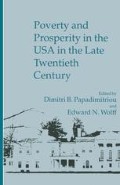Abstract
In 1968, the typical married couple had annual earnings of $25 633 (in constant 1988 dollars)2 from a husband who averaged 47.7 weeks or work, and $4913 from a wife who worked 21.0 weeks. By 1988, the typical husband earned somewhat more, $28 350 per year, while working somewhat less, 45.5 weeks. The typical wife worked substantially more, 32.1 weeks, and earned substantially more, $10 369. For the typical couple, real earnings increased by $8173 per year, of which about two-thirds was attributable to the increased earnings of wives. The typical wife increased her weeks worked by more than half and earned about one-third more per week.3
Access this chapter
Tax calculation will be finalised at checkout
Purchases are for personal use only
Preview
Unable to display preview. Download preview PDF.
References
Acs, G. and S. Danziger (1991) ‘Educational Attainment, Industrial Structure, and Male Earnings, 1973–1987.’ Institute for Research on Poverty Discussion Paper no. 945–91, University of Wisconsin-Madison.
Bean, F. D. and M. Tienda (1989) The Hispanic Population of the United States (New York: Russell Sage Foundation).
Bergmann, B. R. et al. (1980) ‘The Effect of Wives’ Labor Force Participation on Inequality in the Distribution of Family Income,’ Journal of Human Resources, 15, 452–6.
Betson, D. and J. van der Gaag (1984) ‘Working Married Women and the Distribution of Income,’ Journal of Human Resources, 19, 532–43.
Bumpass, L. and J. Sweet (1989) American Families and Households (New York: Russell Sage Foundation).
Blackburn, M. and D. Bloom (1987) ‘Family Income Inequality in the United States: 1967–1984,’ Industrial Relations Research Association Series, Proceedings of the Thirty-ninth Annual Meeting, 349–56.
Blackburn, M. and D. Bloom (1990) ‘Changes in the Structure of Family Income Inequality in the U.S. and Other Industrialized Nations During the 1980s.’ Unpublished paper.
Blank, R. (1989) ‘The Role of Part-time Work in Women’s Labor Market Choices Over Time,’ American Economic Review, 79(2), 295–9.
Cancian, M. and S. Danziger, and P. Gottschalk (1993) ‘Working Wives and the Distribution of Family Income,’ in S. Danziger and P. Gottschalk, Uneven Tides: Rising Inequality in America (New York: Russell Sage Foundation).
Danziger, S. (1980) ‘Do Working Wives Increase Family Income Inequality?’ Journal of Human Resources, 15, 444–51.
Danziger, S. (1989) ‘Education, Earnings, and Poverty.’ Institute for Research on Poverty Discussion Paper, no. 881–89, University of Wisconsin-Madison.
Danziger, S. and P. Gottschalk, and E. Smolensky (1989) ‘How the Rich have Fared, 1973–1987,’ American Economic Review, 79, May, 310–14.
Fuchs, V. (1988) Women’s Quest for Economic Equality (Cambridge, MA: Harvard University Press).
Goldin, C. D. (1990) Understanding the Gender Gap: and Economic History of American Women (New York, NY: Oxford University Press).
Juhn, C, K. M. Murphy, and B. Pierce (1989) ‘Wage Inequality and the Rise in Returns to Skill.’ Mimeo, University of Chicago.
Kakwani, N. C. (1980) Income Inequality and Poverty: Methods of Estimation and Policy Applications (esp. chapter 5, Measures of Income Inequality) (Oxford: Oxford University Press).
Karoly, L. A. (1993) ‘The Trend in Inequality Among Families, Individuals and Workers in the United States: a Twenty-five Year Perspective,’ in S. Danziger and P. Gottschalk, Uneven Tides: Rising Inequality in America (New York: Russell Sage Foundation).
Katz, L. F. and K. M. Murphy (1992) ‘Changes in Relative Wages, 1963–1987: Supply and Demand Factors.’ Quarterly Journal of Economics, 107, 35–78.
Killingsworth, M. and J. J. Heckman (1986) ‘Female Labor Supply: a Survey,’ in O. C. Ashenfelter and R. Leyard (eds), Handbook of Labor Economics (Amsterdam: North-Holland).
Lehrer, E., and M. Nerlove (1981) ‘The Impact of Female Work on Family Income Distribution in the United States: Black-white Differentials,’ Review of Income and Wealth, 27(4), 423–31.
Lehrer, E. and M. Nerlove (1984) ‘A Lifecycle Analysis of Family Income Distribution,’ Economic Inquiry 22, 360–74.
Lundberg, S. (1988) ‘Labor Supply of Husbands and Wives: a Simultaneous Equations Approach,’ Review of Economics and Statistics, 52, 224–35.
Mincer, J. (1962) ‘Labor Force Participation of Married Women: a Study of Labor Supply,’ in H. Gregg Lewis (ed.), Aspects of Labor Economics. Universities-National Bureau Committee for Economic Research (Princeton, NJ: Princeton University Press).
Murphy, K. M. and F. Welch (1993) ‘Industrial Change and the Rising Importance of Skill,’ in S. Danziger and P. Gottschalk, Uneven Tides: Rising Inequality in America (New York: Russell Sage Foundation).
Smith, J. (1979) ‘The Distribution of Family Income,’ Journal of Political Economy, 87, S163–S192.
Thurow, L. (1975) Generating Inequality: Mechanisms of Distribution in the U.S. Economy (New York: Basic Books).
Treas, J. (1987) ‘The Effect of Women’s Labor Force Participation on the Distribution of Income in the United States,’ Annual Review of Sociology, 13, 259–88.
Wilson, W. J. (1987) The Truly Disadvantaged (Chicago: University of Chicago Press).
Wion, D. A. (1990) ‘Working Wives and Earnings Inequality among Married Couples, 1967–84,’ Review of Social Economy, 48, 18–24.
Ruggles, Patricia (1990) Drawing the Line (Washington DC: Urban Institute Press).
Editor information
Editors and Affiliations
Copyright information
© 1993 Dimitri B. Papadimitriou and Edward N. Wolff
About this chapter
Cite this chapter
Cancian, M., Danziger, S., Gottschalk, P. (1993). The Changing Contributions of Men and Women to the Level and Distribution of Family Income, 1968–88. In: Papadimitriou, D.B., Wolff, E.N. (eds) Poverty and Prosperity in the USA in the Late Twentieth Century. Jerome Levy Economics Institute. Palgrave Macmillan, London. https://doi.org/10.1007/978-1-349-22953-6_9
Download citation
DOI: https://doi.org/10.1007/978-1-349-22953-6_9
Publisher Name: Palgrave Macmillan, London
Print ISBN: 978-1-349-22955-0
Online ISBN: 978-1-349-22953-6
eBook Packages: Palgrave Economics & Finance CollectionEconomics and Finance (R0)

